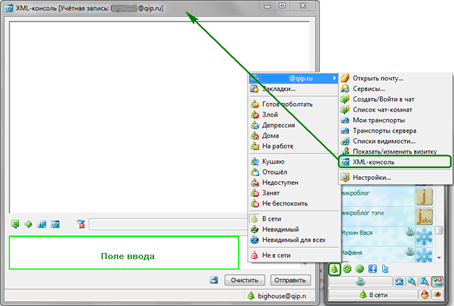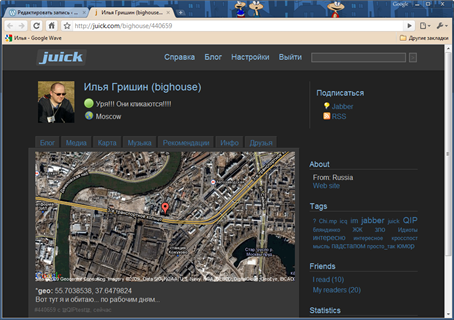QIP Infium & juick.com
This post will be dedicated not to the QIP Infium messenger or even to the juick.com instant blog, as the name might suggest. I will try to devote this article to work in the XML console. Why is this required and why it is necessary to mislead - you ask? And here's why: as many probably already know, and who doesn’t know, in jabber-e, any operations can be carried out using only the direct mode of working with the server through the XML console. But one article will not be able to cover the whole variety of works. Therefore, it was decided to highlight the most obvious options.
Ruyk is known for his developed attitude towards jabber. What can I say, it is actually based on jabber, having a web interface as an optional appendage. However, in this close collaboration, the Achilles heel of the cock is hidden. Not all jabber clients support the jabber functionality to the extent that it is supposed to be used in a bucket. In particular, the cheater assumes the use of the extended statuses XEP-0080 (User Location) and XEP-0118 (User Tune) . But what if the client (or the server on which your nickname is registered) does not allow working with these extensions? Refuse in favor of another server and / or client? Can. But it’s not at all necessary to refuse a convenient client - you can send your advanced statuses yourself.
And now the answer to the second question is why, in fact, QIP Infium was chosen as the experimental rabbit. The answer to this question lies on the surface: this client does not support advanced statuses. The reasons for this, as well as the likelihood of a change in the situation, are not the question of this article.
So here we go. First, open the XML console. What? Surprised by her presence in the queue? But she is. (o_0)

Opened? Now you should be interested in only one field - the "input field" (here we will enter the formatted text, but in essence the command to the server) and one button - "send", which sends what we wrote to the address.
In principle, this could be finished - everything else is beautifully painted on http://juick.info/ , however, we will continue, once started.
1. XEP-0080 (User Location) - an indication of the position on the map.
To send the geolocation in the input field, enter the text of the following structure:
Message text
59.880169
29.829539
Well, with the "Message Text" everything is transparent. But where do you get these strange digits you ask? I am using the point@freefd.info bot . How to add a bot to QIPinfium I hope everyone knows? If not - http://wiki.qip.ru/Bot . We send this bot City Street House
and get a link to the map.
For example, I send the address of my work: Moscow Avtozavodskaya 14
and get
maps.google.com/maps?&v=2&ll= 55.7038538,37.6479823 & z = 17 & t = h & q = loc: 55.7038538,37.6479823
and here we are interested in the coordinates 55.7038538 and 37.6479823
We introduce input field, and send to the address.
Here I live ... on weekdays ...
55.7038538
37.6479823
As a result, we get:

2. XEP-0118 (User Tune) - publication of the name of the song being listened.
To publish music, everything is much simpler, you do not need to find out the location using third-party tools. You probably know the name of the group and song :)
In order to publish the music you are listening to on the chewing blog, in the input field we enter the text of the following structure:
Group name
<strong>Название песни</strong>
For example, I want to publish BI-2 feat. Chicherina, feat. Sim - Christmas (torrent-single)
BI-2 feat. Chicherina, feat. Sim
<strong> Christmas (torrent-single)</strong>
As a result, we get:

3. Other work with the XML console.
If it seemed to someone that working with the console is limited only by these purely specific areas of application, then it is not right. For example, I’ll give you an option to send a subscription request:
type = 'subscribe'
xml: lang = 'ru'>
The message to be sent.
PySy.
You can learn all this, as well as much more, from the official wiki chewing http://juick.info/ and the encyclopedia of helping newcomers to learn Jabber http://jabberworld.info/
Ruyk is known for his developed attitude towards jabber. What can I say, it is actually based on jabber, having a web interface as an optional appendage. However, in this close collaboration, the Achilles heel of the cock is hidden. Not all jabber clients support the jabber functionality to the extent that it is supposed to be used in a bucket. In particular, the cheater assumes the use of the extended statuses XEP-0080 (User Location) and XEP-0118 (User Tune) . But what if the client (or the server on which your nickname is registered) does not allow working with these extensions? Refuse in favor of another server and / or client? Can. But it’s not at all necessary to refuse a convenient client - you can send your advanced statuses yourself.
And now the answer to the second question is why, in fact, QIP Infium was chosen as the experimental rabbit. The answer to this question lies on the surface: this client does not support advanced statuses. The reasons for this, as well as the likelihood of a change in the situation, are not the question of this article.
So here we go. First, open the XML console. What? Surprised by her presence in the queue? But she is. (o_0)

Opened? Now you should be interested in only one field - the "input field" (here we will enter the formatted text, but in essence the command to the server) and one button - "send", which sends what we wrote to the address.
In principle, this could be finished - everything else is beautifully painted on http://juick.info/ , however, we will continue, once started.
1. XEP-0080 (User Location) - an indication of the position on the map.
To send the geolocation in the input field, enter the text of the following structure:
Message text
Well, with the "Message Text" everything is transparent. But where do you get these strange digits you ask? I am using the point@freefd.info bot . How to add a bot to QIPinfium I hope everyone knows? If not - http://wiki.qip.ru/Bot . We send this bot City Street House
and get a link to the map.
For example, I send the address of my work: Moscow Avtozavodskaya 14
and get
maps.google.com/maps?&v=2&ll= 55.7038538,37.6479823 & z = 17 & t = h & q = loc: 55.7038538,37.6479823
and here we are interested in the coordinates 55.7038538 and 37.6479823
We introduce input field, and send to the address.
Here I live ... on weekdays ...
As a result, we get:

2. XEP-0118 (User Tune) - publication of the name of the song being listened.
To publish music, everything is much simpler, you do not need to find out the location using third-party tools. You probably know the name of the group and song :)
In order to publish the music you are listening to on the chewing blog, in the input field we enter the text of the following structure:
For example, I want to publish BI-2 feat. Chicherina, feat. Sim - Christmas (torrent-single)
As a result, we get:

3. Other work with the XML console.
If it seemed to someone that working with the console is limited only by these purely specific areas of application, then it is not right. For example, I’ll give you an option to send a subscription request:
xml: lang = 'ru'>
The message to be sent.
PySy.
You can learn all this, as well as much more, from the official wiki chewing http://juick.info/ and the encyclopedia of helping newcomers to learn Jabber http://jabberworld.info/
